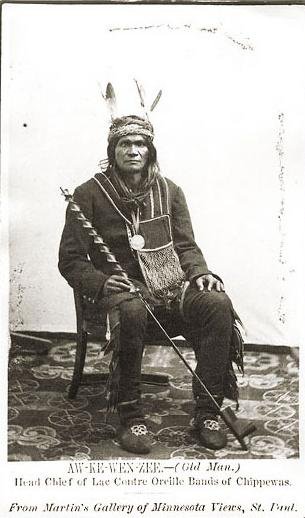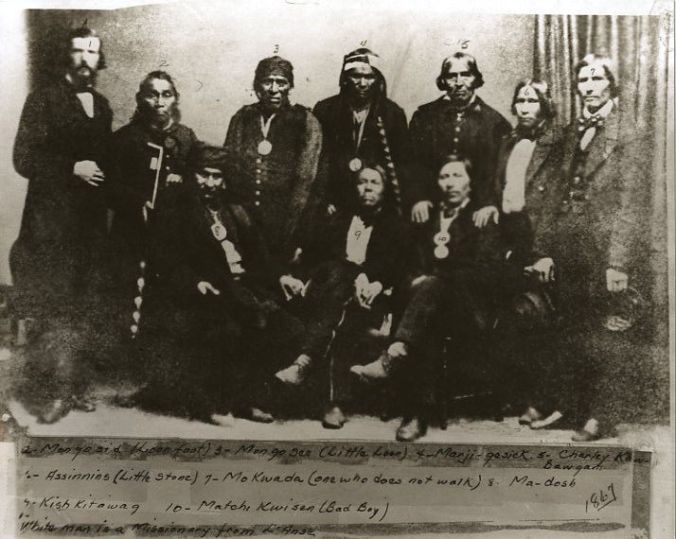
I live in a small town in the Upper Peninsula of Michigan named “Ishpeming”. It, like many town names, is Indian or as some would correct, “Native American”. It is in Ojibwa or the older European way to say it… “Chippewa”. Ishpeming has been interpreted as “high” or “summit” or even “mountain” and “above”. But… it truly does not tell the story of Ishpeming. The meaning has so much more significance than what can be interpreted by those unfamiliar with Ojibwa ways could understand. The word in the past has even been interpreted as “Heaven”. This… would seem to be the most correct idealism and understanding for the word in the context of naming this area Ishpeming. To better understand… I must take you on a journey of an Indian affectionately nicknamed “Old Ish” to tell this story. It is the beginning of the settlement here by European settlers back in 1846. It is a story of why the Indian statue in downtown Ishpeming is known as “Old Ish” and why this town is unique.

You might of once heard of the town being haunted because all of Ishpeming is an old burial ground. This interpretation would be somewhat off in the understanding. Yet, it does certainly give the feeling that is rightfully point on to Ishpeming to me. You see, this place is a place of spiritual beings according to “Old Ish”. It isn’t necessarily haunted by the dead, although this could be… it is unique in being known to Indians as a place of spirits and spiritual beings and to be treated with great reverence and respect. It isn’t evil, but, to Indians, this place does not hold just good beings, it has some that are not. To venture here, was to take unknown risk that may be seen as disrespectful to those beings and therefore, bring their vengeance. This is true regardless of thinking of bad spirits or good or beings. Ojibwa hold great respect for the spiritual world or better understood as the Great Mysterious World. It isn’t important to understand what one can not fully sense or comprehend. But, being so unknown, rightfully commands respect and caution. It would seem a very intelligent way to approach the world to me.

Ishpeming was unique in many ways. It was high and higher than the surrounding area. It was also full of some of the purest iron found in America and steeped in giant bluffs of it. Now, to some, that may not seem very important. However, with so much of this iron brings an extreme uniqueness to the area. Iron causes naturally occurring electromagnetic fields. HERE, it is so significant, that it causes compasses to move and not point true north and this is how they found the iron in the first place here. The electromagnetic fields are known so well, that it’s common knowledge that in certain areas between Ishpeming and parts of Negaunee where the iron is, the cell phone coverage is affected. It’s known to electricians that the electricity may pulse, be erratic and may need special consideration in the area. People that live here know how the lights blink because of it and it’s even been said it’s haunted for that reason. But… also… the human senses can pick up this electromagnetic field in sensations such as the feeling of being watched, but… this isn’t all.
Imagine if you will, giant bluffs of rock that sparkle and even have hews of blue, pink and gold. Imagine during a lightening storm what would happen to HUGE piles of iron. The lightening DANCES upon the ground in a very unique way. Now, how would you expect the natives to see this? Such extreme phenomena would certainly be seen as spiritual even by today’s standards. Today, we have buildings and trees and with the hub bub of the city, don’t notice what the Indians once did. THIS is the place I live!
Now, “Old Ish” was often called this, as I believe… he was named after this place and it after him. His true name is Marji Gesick. Now, that is pronounced… Maaa zz shee… Gay shig… in reality. They (those interpreting) were from Boston and often put “R’s” where there didn’t need to be them. As New Englander’s do not pronounce R’s. Now the name is two words. Marji or Mahzshee meaning “bad”, “not good”, “ominous”. Geshig (Gesick) means “Sky”, “above”, “heaven”(well… spirit world high up). You see, the word Day didn’t really interpret into Ojibwa language, because, it denotes time. The sky is a better way in which they see things. It also denotes the ability to encompass all around you and above. So in a sense, it means “Bad Sky” or as I like to think… “Stormy Sky”.
His name has been interpreted as “Flying Sky” and “Crossing Sky”. If you realize WHAT they were trying to explain to white men of the time… moving skies, like stormy skies would seem accurate.
So who was Marji Gesick? At one point, he is called the sewer or better translation, the patcher or fixer. Perhaps he worked for the Hudson Bay Canoe Company fixing their canoes at one time or maybe he just knew how to do just about anything in the wild. He was certainly known as highly intelligent, handsome, as a experience guide of the wilderness that knew the entire area (even Ishpeming) like the back of his hand and knew everything he needed to know to survive, from animals, to where to hunt and fish, to the people’s that lived in the area. The area…. was the entire surrounding area around Lake Superior. What people do not realize these days is how much Ojibwa counted on their canoes and how far they used them. There are stories of them paddling against the current the entire length of Lake Michigan to save some white people single handedly. They migrated back and forth around the land. The lakes and rivers were their highways. This is why Marji Gesick was so well respected by the tribes (which numbered many clans and as far south as lower Michigan and far west as Minnesota), for the vast wisdom he had. The people who came here to find the iron ore, knew of Marji Gesick and his knowledge of the area. This was helpful when encountering the native people as well. Marji Gesick was known for keeping peace and being an agent for both sides and it appears to me at least, he traveled far to do so. He is pictured above with a medal from President Lincoln (I believe) that was given in honor of peace keeping agents. Back then, people didn’t bring meals, they depended on guides to help them survive fully and guide them to where they needed to go.
Soooo… this means that the people who came up here to look for ore, did so with the thought of employing the great guide, Marji Gesick. He knew of it and where it was. But, he did not know the significance and it’s use and to him, it was of little use. Copper was by far the better metal.
Now, I’ll tell you, that much of the history of the Ojibwa is corrupted in misinterpretations and misunderstandings. Yet, even today, it can be pieced together. I found a picture of Marji Gesick online. I also found he had a very exceptionally long pipe that had twisted wood on a large part of it. It is unique. I found another picture with the same pipe and appearing to be the same person and he is called “Old Man of the Mountain”. These are pictured in Minnesota, along with Marji Gesick on old cabinet cards or what I consider, “collector cards”. Some of them are stereo view where people can view the pictures that are black and white in a 3D way. As you can see… Old Ish makes sense if he was considered “Old Man of the Mountain”
But… what does he look like? Well, I have no doubt that people were alive when the statue that was mass produced and sold to many towns knew Marji Gesick personally in their lifetime. One of the pictures dates 1867. The statue is from 1880’s. You see, the picture I have… that was once a cabinet card with “Old Man of the Mountain” looks like the statue. Yes it does. Now, it’s a bit off. He has much broader and stronger brows and cheek bones and he’s much handsomer than the rendition of the statue, but yet, one can not miss the likeness and think it would certainly make sense to call the statue, “Old Ish”.
So what did “Old Ish” say about his namesake town? He told people where to get the ore and showed them an area where the iron was blue, gold and pink (likely from the heat of a lightening strike” that was at a base of a fallen giant tree. He told them where there was a mountain of it and as some of the story goes, made a map on the sand with a stick. Some say this was Jasper Knob and it never did produce the iron to make money. Neither was it pure enough, nor, a way to transport the ore. Some reports say it is where Jackson Mine was, which stands as a giant enormous man made pit today and one can envision why that would be and what was there so many years ago. Either way, Marji Gesick’s warning was evident and he would not go to the area. He told of the lightening dancing on the ground and the spirit beings and cautioned them. I do believe they mistook his reluctance to go as being something he thought evil. However, one being, that is to be held in the highest esteem and respect is the Thunderbird, being a creature that is like the eye of the creator. He is the protector, the guide, and yet… he is NOT something you play with and just walk upon all willy nilly.
I have to think that “Old Ish” was named “Marji Gesick” because, he came to Ishpeming and experienced the lightening for himself, seeing it. He experienced the high electromagnetic fields and character of the area from the iron and it’s WHY he was named what he was and why he’s remembered and called “Old Man of the Mountain”. I have no doubt that the area was envisioned with the Great Creator and his Thunderbird and spirit creatures, both good and bad (remember Ojibwa do not think in terms of good and evil in beings the way many Christians do). I have no doubt that the entire area of Ishpeming, was respected and avoided because of it’s spiritual significance to them and why Ishpeming was interpreted as “heaven”. So the next time you just think of this little town called Ishpeming as just another town, remember it’s past and it’s significance to the Ojibwa and especially to the Ojibwa man who is named after it and him after the area. It is always good to remember the ancestors and respect their wisdom. It’s WHY the statue has such significance to the people here.
Darlene Watts